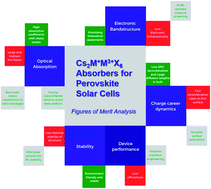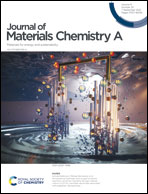Reliability of 3D Cs2M+M3+X6 type absorbers for perovskite solar cells: assessing the figures of merit
Abstract
In the realm of perovskite-based solar cells, the quest for lead-free absorber materials is the epicenter of research. The search has led to the development of various lead-free compounds that have the potential to deliver efficient, air-stable, low-cost, and environment-friendly perovskite solar cells. Inorganic lead-free halide double-perovskites (IHDPs) like Cs2M+M3+X6 (M+ = metal, M3+ = pnictogen, X = halide) are consistently being reported to demonstrate long carrier diffusion lengths, large free-charge mobilities, and longer thermal stability. They are easy to synthesize and are compositionally tuneable for desired structural and electronic band structure. The experimental power conversion efficiencies (PCE) of solar cells based on these inorganic materials have not yet exceeded 3%, thus keeping up hopes of research on double-perovskite-based photovoltaics. A detailed track record against a set of qualities for developing efficient Cs2M+M3+X6 type materials or in general inorganic hybrid double perovskites (IHDPs) will help us look ahead in the right direction. This minireview discusses the theoretical assessment of the electronic band structures of IHDPs, stability with respect to their phonon dispersion relations and thermodynamics, and strategies employed for tunability of their optical band gaps and for enhancement of carrier lifetimes and mobility, followed by listing figures of merit for using them in solar cells. Finally, current challenges and perspectives for use of these materials for the said application are presented.



 Please wait while we load your content...
Please wait while we load your content...